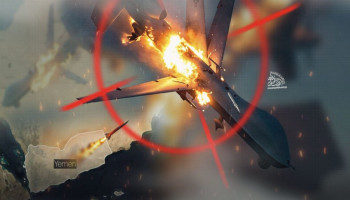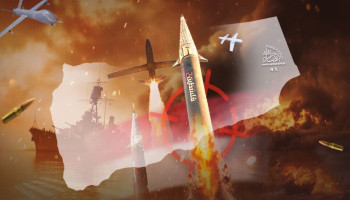For decades, the United States has maintained its status as the world’s greatest superpower—an untouchable force that no one dares to defy. Those who have attempted to stand against it have faced devastating consequences, as history has shown time and time again. The destruction, mass killings, resource plundering, and military dominance inflicted upon Iraq, Afghanistan, Syria, and occupied Palestine serve as undeniable proof of America’s ruthless grip over the Islamic world. The region’s rulers and people alike have been forced into submission, with many even assisting Washington in executing its criminal agendas.
Yet, amidst this long-standing global reality, Yemen stands alone. It is the only country that has successfully engaged in direct warfare against the United States, targeting its commercial vessels, warships, and aircraft carriers for over a year. At the same time, Yemen has also struck deep into Israeli-occupied territory with ballistic, cruise, and hypersonic missiles, alongside precision drone attacks—forcing millions of Zionist settlers into bomb shelters.
From the very first week of Operation al-Aqsa Flood until the final hours before the ceasefire took effect, Yemen remained steadfast in its attacks on American and Israeli interests. The escalation was methodical, intensifying strategically in direct response to the developments in Gaza. With carefully calibrated military strikes and highly advanced weaponry, Yemen demonstrated a mastery of warfare—navigating through five distinct phases of battle while continuously enhancing its capabilities to target and strike with maximum precision. The effects of this campaign have been felt on military, economic, and psychological levels, reshaping the regional and global power dynamics.
Yemen’s Strategic Superiority
Several factors set Yemen apart in its stance on Gaza. Its prime geopolitical position, directly overseeing the Bab el-Mandeb Strait—a key global trade artery through which one-third of the world’s commerce passes—gives Yemen unparalleled leverage. Moreover, under the wise leadership of Sayyid Abdul-Malik Badruldeen al-Houthi, Yemen has defied expectations, overcoming severe resource limitations to emerge as a formidable force capable of altering regional and international equations. His leadership has steered Yemen away from Western dominance, rejecting imperial arrogance and championing a future defined by sovereignty and dignity, where the Yemeni people hold the ultimate say.
Yemen’s victory formula is built on three pillars: a Quranic vision, an exceptional leader, and a people of wisdom and faith. Combined with its rich history and strategic location, these elements have translated into tangible battlefield successes. The ( Promised Victory and Sacred Jihad ) battle has been a testament to the nation’s resilience, intelligence, and ability to adapt under extreme circumstances.
Yemen’s Unmatched Support for Gaza
Yemen’s support for Gaza has been a decisive factor in the confrontation with the Zionist entity. Unlike any other nation, Yemen stood firmly, both officially and with great public support, in solidarity with Gaza. The result? The unprecedented shutdown of occupied Umm al-Rashrash "Eilat" port—the first such occurrence in its history. Furthermore, Yemen’s naval operations effectively brought "Israeli" shipping in the Red Sea and the Arabian Sea to a standstill, triggering a deepening economic crisis for both the Israeli entity and its backers. According to an investigative report by the British agency Iconist, Yemen’s maritime attacks have caused economic losses exceeding $200 billion.
Yet, Yemen’s impact has extended far beyond the global economy. The country has dealt direct and painful blows to the U.S. Navy, successfully targeting 30 American commercial vessels and engaging in more than 93 direct confrontations with U.S. warships and aircraft carriers. This marks a historic first—never before has a nation dared to launch sustained, direct strikes against the U.S. fleet on such a scale.
In addition, Yemen has introduced two high-impact weaponry into the conflict: the Yaffa drone and the Palestine-2 missile. These advanced armaments have overwhelmed the occupation’s defenses, driving millions of Zionist settlers into bunkers. Meanwhile, the U.S.-led coalition, despite comprising dozens of nations, has utterly failed to stop or even mitigate Yemen’s military operations, exposing the limits of American military might.
America’s Struggle to Restore Its Image
Had any other nation launched such an extensive campaign against American and Zionist military assets, Washington’s response would have been swift and brutal. However, Yemen’s growing military capabilities, coupled with its people's unwavering determination, have placed the U.S. in an unprecedented predicament. With no viable means of deterrence, Washington has opted for a policy of media silence and distraction—avoiding public acknowledgment of the serious blows it has suffered. This approach stems from America’s recognition that Yemen is unlike any other adversary. It is battle-hardened, fearless, and fully committed to its cause, making any attempt at subjugation an impossible endeavor.
After ten years of failed attempts to weaken Yemen through regional proxies like Saudi Arabia and the UAE, the U.S. now finds itself with few options. Even within the Pentagon, it is acknowledged that the American military is unprepared for a ground war in Yemen. Furthermore, Washington’s regional allies are too vulnerable—any escalation against Yemen could lead to catastrophic consequences. For instance, Saudi oil exports could be entirely shut down, pushing global oil prices beyond $1,000 per barrel. Likewise, Yemen has the capability to destabilize Dubai and Abu Dhabi, both of which are crucial economic hubs for the UAE. The stakes are simply too high for Washington to ignore.
U.S. Failure and the Reality of Yemeni Strength
Yemen’s ability to strike the U.S. Navy has shattered the long-standing illusion of American invincibility. In its first direct confrontation with U.S. military forces, Yemen has managed to force Washington into admitting the complexity of the battle, as well as the precision and sophistication of Yemeni weaponry.
During its operations in support of Gaza, Yemen has targeted 30 American commercial vessels and engaged in 78 naval battles against U.S. warships. In a striking admission, the deputy commander of the U.S. Navy recently confirmed that Yemen has attacked a total of 140 commercial ships and 150 military vessels.
The following table outlines Yemen’s military engagements against U.S. naval forces:
- American Commercial Vessels Targeted by Yemeni Forces
- Yemeni Armed Forces Engagements with U.S. Warships













